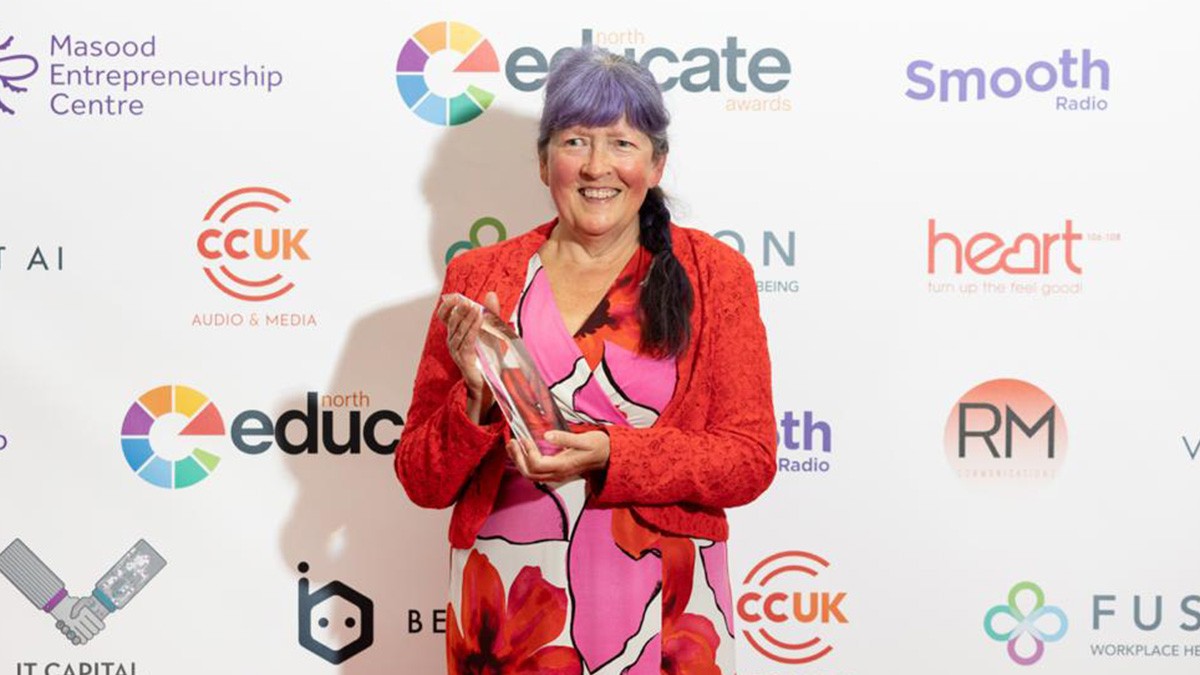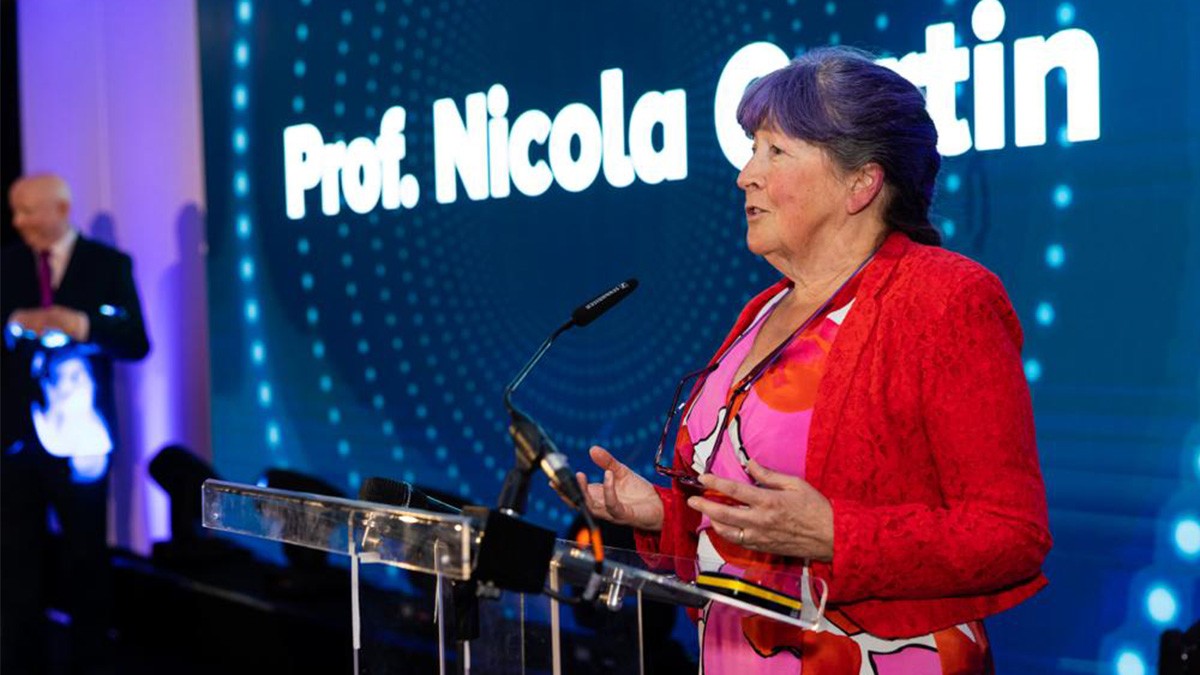Full-length Q&A with Professor Nicola Curtin
Professor Nicola Curtin, who studied a PhD in Biochemistry at Surrey from 1977-1981, is our Alumna of the Year in the Vice-Chancellor’s Alumni Awards. Nicola has enjoyed a prestigious career in medical research and her work on PARP inhibitors has paved the way for novel cancer treatment across the globe…

“Not every scientist gets the opportunity to see their work have an impact. I’m quite fortunate in that respect," says Nicola
Why did you choose to study at Surrey?
After completing a degree in biology at York University, I secured a place in Manchester to study liver carcinogenesis, that is how cancer develops, in vitro, for a PhD. But my supervisor left for a job in the USA in my first year and the project didn’t really stimulate my mind enough.
Fortunately, I saw an advert for a PhD in liver carcinogenesis at Surrey under Dr Keith Snell. The project explored the hypothesis that the liver could return to an embryonic state during carcinogenesis via a process called retro differentiation. This is a sort of reverse development. This was interesting because it compared the development of cancer with liver regeneration.
What were the best things about conducting research at Surrey?
I have fond memories of working under Keith. We still exchange cards at Christmas. I’m in touch with a couple of other people from that period, too.
We shared the laboratory with several PhD and post-doctoral students. We were a diverse group. Keith also had a technician and another PhD student who were working on separate aspects of liver biochemistry. I was the only one looking at cancer, but we fed off each other in terms of ideas.
Professor Vincent Marks was the Head of the Department of Biochemistry and Nutrition, and there was a strong focus on liver metabolism, drugs and toxins.
What was it like to be a woman in sciences in the 1970s?
I don’t think I felt much in the way of discrimination in the early years. Biological sciences have generally been quite equal in their gender split at the lower end of the career ladder. But women get filtered out as you progress upwards. As you reach senior lecturer or professor status, it becomes male-dominated.
That’s something we need to address. People say it’s a pipeline issue. But that’s clearly not the case when we've had roughly equal numbers of men and women graduating for the last 50 years.
What’s your happiest memory of your time at Surrey?
There were many. I remember reading The Journal of Irreproducible Results in the Library. It was a spoof scientific publication that featured articles such as Maze-Learning by Angels and The Benefits of Cakus Chocolatus.
One key takeaway was having the time to ponder things. I’ve always been a bit of a daydreamer. If somebody posited an idea, I’d often start working it through in my head and lose track of the rest of the conversation. But that’s a good quality for a scientist. You often read bits of information and think, “What if…”
What was the key scientific discovery you made at Surrey?
It was finding out that there were biochemical similarities between a naturally regenerating liver and one that was becoming cancerous.
This was different from what other people were saying at the time. But they were examining what was going on in the biochemistry 24 hours after surgery. We discovered that the key changes happened 48 hours after surgery. This suggested there were new potential routes for tackling liver cancer.
What did you do after graduation in 1981?

Trekking in the Himalayas gave Nicola more confidence and a sense of proportion
I went to Bristol to live with my boyfriend and save up so we could travel around India and South-East Asia. We set off with just a guide book. There were no mobile phones in those days and airmail letters took weeks to arrive home. But we did amazing things, such as trekking in the Himalayas. I’m glad I did that. It gave me more confidence and a sense of proportion.
When I came back to the UK, the first job I landed was in Newcastle. This time, I was investigating different treatments for liver cancer, which included working on a novel antifolate drug. This was being developed at the Institute of Cancer Research in Sutton and it was further developed into the drug pemetrexed. Its brand name is Tomudex. It’s used for cancer therapy. That was my first post-doctoral post.
What prompted you to focus on developing cancer drugs?
I wanted to conduct medical research from my early teens. The goal was to understand disease and improve treatments. I was lucky when Hilary Calvert, who’d been at the Institute for Cancer Research, moved to Newcastle to start a drug discovery unit.
The antifolate project I was working on had led to something that was a perfect fit for their theme. I joined as one of five members of his team. That was in 1990 and it coincided with the birth of my daughter.
It was tough at first. I took on not only my own project, but also the evaluation of novel PARP inhibitors (PARPi), which was one of the other projects under the theme. It was exciting to think I might be involved in a drug that would ultimately benefit cancer patients.
I spent 20 years in the drug discovery unit and I worked on a lot of projects. But my main interest was in DNA repair and PARPi.
Can you explain more about PARPi?

Nicola's ground-breaking research means we can target cancer cells in certain patients without harming normal cells
PARP stands for Poly(ADP-ribose) polymerase and it’s an enzyme that helps repair DNA. Your DNA is damaged all the time through your own metabolism or from common environmental sources such as normal solar radiation. Most of the damage is generated internally by a normal metabolism.
The most common type of DNA damage involves single strand breaks. You have two strands of DNA. If you get a nick in one, PARP is involved in the repair. If you can inhibit PARP, you can stop the repair process.
We were developing PARPi for use alongside certain types of chemotherapy and radiation that nick the DNA. The idea was that by stopping the tumour repairing its DNA damage, the chemotherapy would be more effective.
How did you develop PARPi to fight cancer?
We had a lot of lucky accidents along the way. The first involved us trying to make a compound we thought would inhibit PARP. But during its synthesis, it underwent a molecular rearrangement and it gave us a compound that was 50 times more potent than the one we were trying to make.
The other big break was that Zdenek Hostomsky from Agouron Pharmaceuticals heard about our work. He met us at an event in Amsterdam and we agreed to give him our best inhibitor. He coupled this with related advances from labs in Germany and France. That enabled the design of better inhibitors. This ultimately led to the creation of rucaparib, which now has the brand name of Rubraca.
That was the first PARPi to go into clinical trial for the treatment of cancer. That was in May 2003 and it was in combination with a chemotherapy drug called temozolomide. Bizarrely, because it had gone into clinical trial, it wasn’t considered to be a drug development project any more. So it was dropped as an area of study.
That wasn’t the end of the story, was it?
Fortunately, I’d started working with Thomas Helleday and his group in Sheffield. What he’d shown was that cells that were defective in DNA single strand break repair – or in which PARP was inhibited – were massively dependent upon another repair pathway called homologous recombination DNA repair. Cells defective in that pathway were sensitive to PARPi.
That struck a chord with me. Being involved in the cancer area, I knew that breast and ovarian cancer susceptibility genes BRCA1 and BRCA2 were involved in that homologous recombination pathway. So it suggested to me that PARPi could be successfully used to treat breast and ovarian cancer in patients who had those genetic mutations.
And that hypothesis was correct?
Yes. The reason it works is that single strand breaks happen very frequently in DNA because of our normal metabolism, and PARP is part of the first line of defence with BRCA1 and BRCA2 being part of the back-up pathway. It's like wearing a belt and braces. If one fails, the other does the job.
So if a cell with a BRCA mutation is exposed to a PARP inhibitor it can’t repair its DNA either way and it dies. Exploiting a defect that on its own doesn’t kill cells, in this case BRCA mutation, by targeting something else that also on its own doesn’t kill cells, in this case PARP, is called synthetic lethality.
It's an exciting way to target the cancer cells specifically without harming normal cells that don’t have the defect.
That’s because normal cells, even in someone who is a carrier of the mutation, like Angelina Jolie, inherited from one or other of their parents. But they still have one functional gene from their other parent. Only in the tumour is the remaining good gene lost, and that is what probably makes the initial cell turn into a cancer cell in the first place. So with a PARPi, we are exploiting the defect that actually caused the cancer.
I think that’s quite cool. Research can often be a bit like a detective story, where you bring bits of information that you’ve gleaned over the years together to generate an idea that you can test. That’s what happened in this case.
In 2005, you published this breakthrough research in Nature…
The article we published suggested a very different way of thinking about how to treat cancer.
At that time, therapies for cancer were mostly like poisons aimed at damaging cells, which was why they caused side-effects. Or they were trying to overcome some aspect of the tumour biology that made it stronger.
Exploiting a tumour-specific DNA repair defect that created a vulnerability, its Achilles’ heel, meant it should only kill the tumour and not be as toxic to the patient.
It was a new concept in cancer therapy. There was some scepticism at first. But when the first clinical data came out and it showed that the PARPi worked, it gave lots of drug companies added incentive to press further ahead with developing this type of treatment.
Which brings us back to Rubraca...
We’d already developed Rubraca. It was the drug we took into clinical trial in combination with chemotherapy in 2003. However, the chemotherapy combination was increasing the toxicity in line with the anti-cancer activity. It was only when we showed that you could exploit a cancer-specific defect with a PARPi alone that clinical trials accelerated.
Olaparib was the first PARPi to show clinical benefit in cancers with BRCA mutations. Rubraca was next to be approved. It was first approved by Food and Drug Administration in America in 2016, then the European Medicines Agency and, finally, by the National Institute for Health and Care Excellence in the UK.
It was a bit frustrating that Rubraca wasn’t the first PARPi to be approved. I remain delighted, however, that they are a successful tool in combating cancer, and we helped drive that treatment forward.
The trials, though, meant I had time to pursue another idea I had when I was working with the ovarian cancer group.
Can you tell us about that?
This is another example of how research can be like a detective story. Ovarian cancer is mostly treated with a drug called carboplatin. I knew BRCA mutations and other defects in the DNA repair pathway made cells more sensitive to carboplatin.
The response rate to carboplatin is around 60 per cent. But only about 20 per cent of ovarian cancer was associated with BRCA mutations. That made me suspect we were underestimating the frequency of defects in homologous recombination by focusing only on BRCA mutations. We started collecting ovarian cancer cells from patients undergoing surgery and testing them for their function of this pathway.
We showed that around 60 per cent of the patient samples had the defect, even though we were collecting from patients not known to have BRCA mutations or a family history of the disease.
That meant that PARPi would be effective against 60% of ovarian cancers rather than just 20% with BRCA mutations.
Tell us about the Curtin PARP Fund…
When the University of Newcastle sold its stake in Rubraca, the total amount I earnt from that was £865,000. It was like winning the Lottery. It was a massive sum I wasn’t expecting. I’d already been paid for the work as it was part of my day job. I have a small family and we all have enough money to live comfortably. I felt it could be put to better use.
Some of the people I went to Zumba with were involved with charities. I contacted people who ran scientific funding charities, too. Everything seemed to lead back to the Community Foundation and they’ve been wonderful.
Together, we set up the Curtin PARP Fund, which this time stands for Passionate About Realising Your Potential rather than Poly(ADP-ribose) polymerase. The aim of the Fund is to help disadvantaged people overcome barriers to education and employment, and generally to have a more fulfilling life.
Since the initial donation in 2019, we’ve given out nearly £160,000 using the interest alone. Not all the grants will be successful, but even a relatively small sum like £1,000 can pay for a laptop. That will enable somebody to undertake the training that allows them to get promotions and have a more interesting job. It’s better for them and it’s better for society if people can make the most of themselves.
On a bizarre side note, the pub over the road from the Community Foundation is where the adult comic, Viz, started. That has a character called Johnny Fartpants. ‘Parp’ in another context featured prominently in his adventures!
I understand you’re retiring soon…

"Thousands of graduates who’ve done amazing things have studied at the University. To be selected out of all of those is a huge honour," says Nicola
I’m retiring next year. It probably won’t be full retirement. I’m hoping to get emerita status at Newcastle and I’m still collaborating with a clinician who works in India. She’s doing a clinical trial, based on our experimental data, exploring if different schedules of Rubraca – that may be equally effective but less toxic – could be more affordable for the women in that country.
I’m also the editor-in-chief of the journal, Expert Reviews in Molecular Medicine, and I’ll keep a hand in there.
One of the main things I’ll miss is the daily interaction with young people. Taking an undergraduate or postgraduate student and enthusing them about science and the scientific method is something I’ve enjoyed. Turning a student into a scientist is immensely rewarding.
Your research has saved hundreds of thousands of lives. Do you ever take time to enjoy that achievement?
Not really. It’s nice to know I’ve made a difference. But I realise a lot of scientists put in a lot of hours and get nowhere. Not everybody gets the opportunity to see their work have an impact. I got quite fortunate with this.
I’m very happy I’ve been able to use the success of Rubraca to set up the Curtin PARP Fund, though. That will continue to help people when I’m no longer here.
What advice would you offer students wanting to follow in your footsteps?
Do your best. It doesn’t matter what you go into, but try to do something you’re passionate about. You don’t want to be in a job where you’re just there for the money. Find something that’s stimulating, too. If you’re doing it for eight hours or more a day, it needs to inspire you.
You’ve also got to remember that life’s a lottery. Recognise good luck when it comes your way and make the most of it, and learn from your setbacks and misfortunes.
One thing I advise my students to do is to apply for prizes. Funnily, I’d never considered doing it myself, then one of my colleagues put me up for the Ruffalo Award and I won it. So don’t be shy. It doesn’t cost you anything to apply and it’s a way you can stand out from the crowd.
Finally, what does it mean to be our Alumna of the Year?
It’s a lovely thing to win. Think of how many thousands of graduates have been through the University. To be selected out of all those is a huge honour. Surrey got me started on my career path, so it’s nice to have it come full circle.
I also hope that my experiences motivate other students to fulfil their dreams and to do their best.
And not just for themselves, but for other people, too.